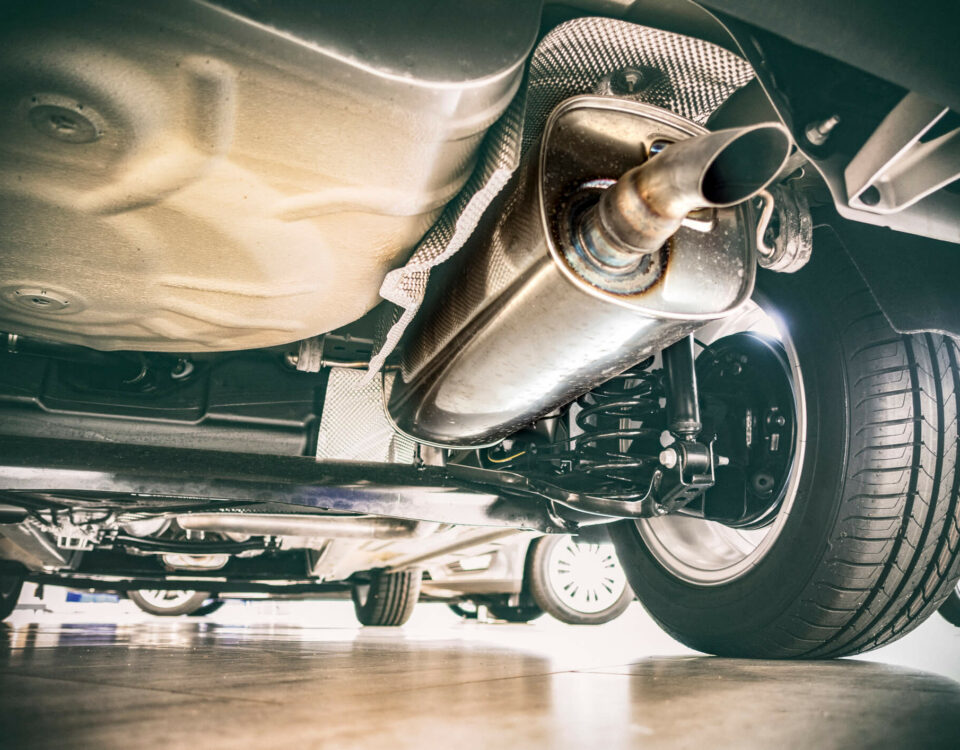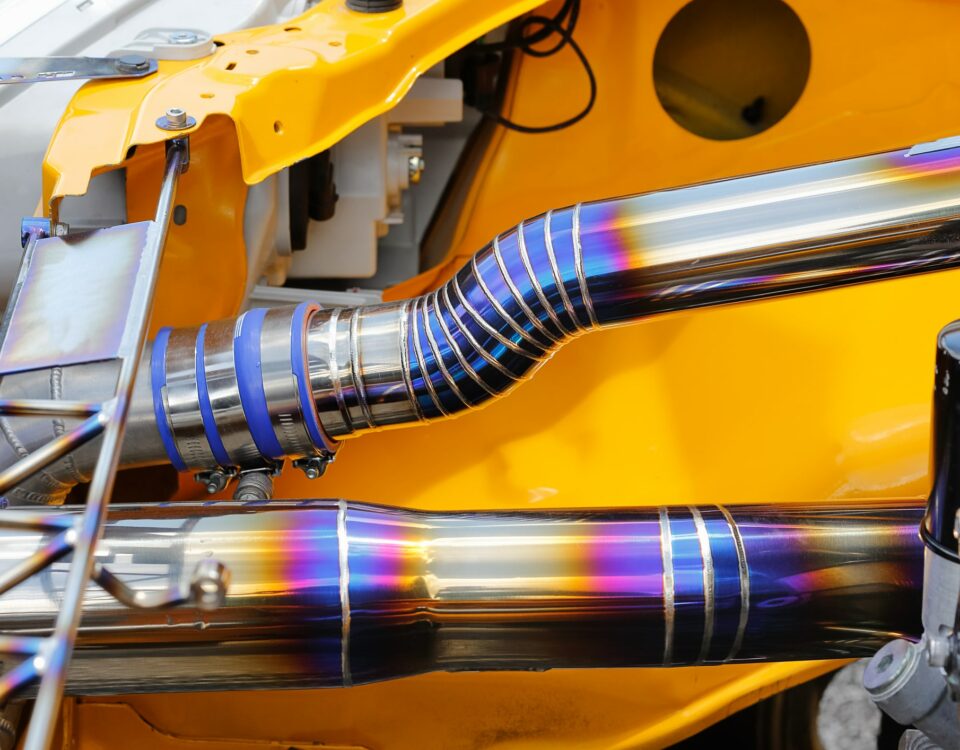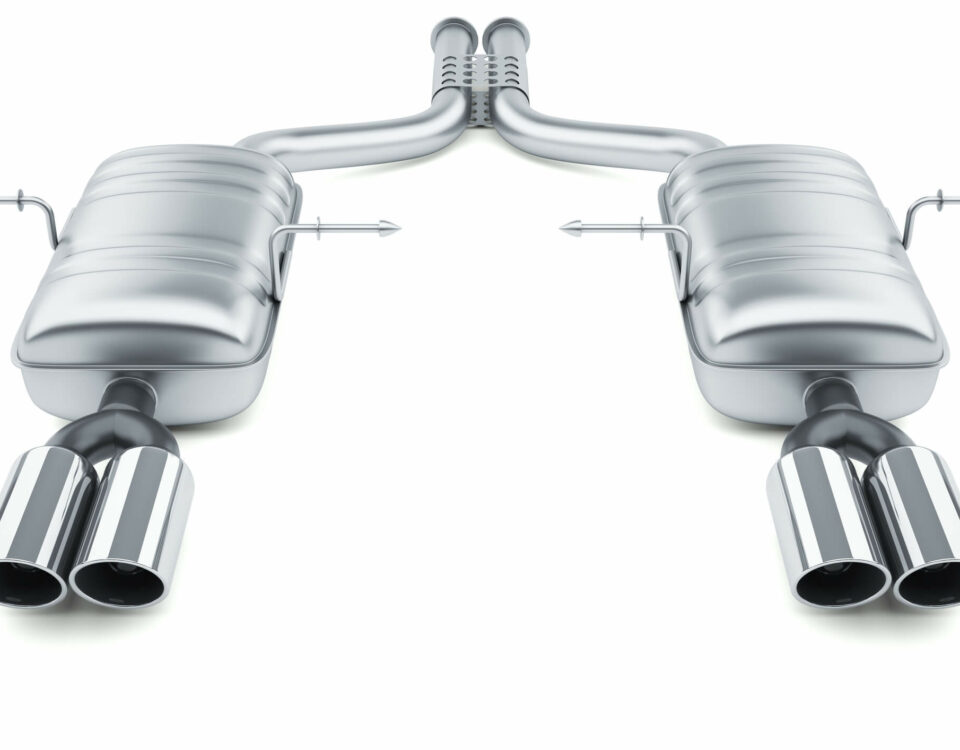Delivering the Perfect Sound to Cars with Mild Steel or Stainless Steel Exhaust
To enhance the sound of your car, custom exhaust systems are essential. The performance and sound properties are often considerably impacted by the material selection of your exhaust system, including stainless steel or mild steel. Let’s investigate how each material affects the exhaust sound:
Differences between Exhausts Made Of Mild Steel and Stainless Steel
The composition is the key difference between mild steel and stainless steel exhausts. Whereas mild steel is formed of iron alloyed with carbon, stainless steel is composed of iron alloyed with chromium and nickel. Chromium gives stainless steel a further layer of corrosion resistance; nevertheless, it is also more costly than mild steel. Although mild steel is not more expensive than stainless, due to its higher carbon content, it rusts more readily. So, if you reside somewhere with a lot of moisture or salt water, you could opt for a stainless steel exhaust system instead since it won’t just as easily over time. Additionally, stainless steel is often stronger than mild steel because of the presence of chromium, which renders it more appropriate for performance vehicles that require higher engine output levels. However, since mild steel is frequently less expensive than stainless steel, it has the benefit of being cheaper when it concerns installation expenses. Furthermore, it’s simpler to work with throughout setup which could result in a quicker turnaround for your project or repair job. In addition, mild steels tend to be quieter than their stainless counterparts because they often don’t include any chromium aspects, rendering them a great option for anyone who seeks a calmer ride or is concerned with reducing noise pollution from their vehicle’s exhaust system.
The Making of a Custom Exhaust System
Among car enthusiasts and anyone who cares about performance, designing a bespoke exhaust system for their car is a common alteration. A bespoke exhaust system may make a vehicle sound better, look more stylish, and increase motor performance. An outline of the steps needed to create an individualised exhaust system is provided below:
1. Planning and Design:
Building a custom exhaust system begins with the design and planning stages. Establish the objectives of the alteration, whether they be to increase performance, produce a certain sound, or improve looks. Take into account the material to be used (such as titanium, stainless steel, or mild steel) as well as the exhaust configuration (single or dual exhaust). To achieve a correct fit and operation, the development process comprises rigorous measurements and assessments.
2. Material Selection:
Pick out the components of the unique exhaust system. Stainless steel is a preferred material because of its dependability, resistance to corrosion, and appealing look. Depending on the budget, the level of performance needed, and personal preferences, other materials like titanium or mild steel might be employed.
3. Fabrication:
The fabrication procedure entails cutting and bending the chosen material to the precise measurements and specifications of the vehicle. The unique exhaust components are made by skilled fabricators using specialised instruments including pipe benders and welding equipment.
4. Mandrel Bending:
Mandrel bending is a method employed to keep the exhaust tubing’s diameter constant and create seamless bends. It avoids any crevices or crimps which can impair the performance as well as the flow of the exhaust.
5. Welding:
A unique exhaust system must be meticulously welded. It guarantees that the parts are connected tightly and stops leaks. Tungsten Inert Gas welding is a process used by skilled welders to produce strong, flawless welds.
6. Catalytic Converters and Emission Compliance:
If the custom exhaust system is meant to be used on public streets, it needs to abide by local emission standards. It can entail including emission-controlling devices like catalytic converters in the layout.
7. Hangers and Mounting Points:
To attach the bespoke exhaust system to the car’s chassis, suitable hangers and mounting points are necessary. By keeping the exhaust stable and in line with the body, these hangers guard against rattles and other harm.
8. Heat Shielding:
Heat shielding can be added in hot climates to shelter neighbouring parts and the car’s body from excessive warmth produced by the exhaust system.
9. Testing and Adjustment:
It’s crucial to test the custom exhaust system for leaks, fitting, and quality of sound after it has been constructed and fixed. The sound could be tweaked or any problems that surface while testing may be fixed.
10. Finishing Touches:
Any uncovered welds or edges are polished to give the bespoke exhaust system a polished, finished look. Exhaust tips may be installed to improve the way the whole thing looks.
11. Legal Considerations:
Local rules and ordinances governing vehicle alterations and noise levels must be taken into account when designing a bespoke exhaust system. It’s crucial to make sure the custom exhaust conforms to these standards because some areas have special restrictions on exhaust changes.
12. Expert Installation:
Building an individual exhaust system is a difficult task that calls for expert expertise. To guarantee that the system is set up securely and properly, it is advised to enlist the help of skilled exhaust fabricators or car experts.
Types of Mild Steel and Stainless Steel Exhaust
Car exhaust systems are most frequently made of mild steel and stainless steel. The categories include several sorts and grades which provide various traits and features within every category. Let’s examine the various stainless steel and mild steel exhaust types:
Different Mild Steel Exhaust Types
Mild Carbon Steel:
The most fundamental and frequently utilised kind of mild steel for exhaust systems is mild carbon steel. It has a little amount of carbon along with additional alloying substances. Whilst mild carbon steel is less expensive and easier to deal with than stainless steel, it tends to be more prone to rust and corrosion.
Aluminized Steel:
Aluminized steel is mild carbon steel that has an aluminium-silicon alloy coating applied to it. The material’s corrosion resistance is improved by this coating, which renders it more resilient than untreated mild steel. Frequently found in affordable aftermarket exhaust systems is aluminized steel.
Galvanised Steel:
To stop rust and corrosion, mild carbon steel is coated with an additional coating of zinc to create galvanised steel. Although it provides superior weather resistance, it is less frequently utilised in exhaust systems because of worries that it will produce harmful gases when heated.
Many Stainless Steel Exhaust Types:
Austenitic Stainless Steel (E.G., 304, 316):
The most typical type of stainless steel used in vehicle exhaust systems is austenitic stainless steel (e.g., types 304 and 316). High amounts of nickel and chromium give it outstanding durability and resistance to corrosion. Concerning its tolerance to heat and extreme circumstances, stainless steel grades like 304 and 316 are preferred options for performance exhaust systems.
Ferritic Stainless Steel (E.G., 409, 439):
A different kind of stainless steel employed in exhaust systems is ferritic stainless steel (for example, 409, 439). It costs cheaper than austenitic stainless steel but has a higher chromium content. Although it has strong corrosion resistance, it might not have the same levels of heat resistance as austenitic grades.
Martensitic Stainless Steel (E.G., 410, 420):
Martensitic stainless steel, such as types 410 and 420, is less frequently used in exhaust systems. It contains a lot of carbon & may be heated to make it stronger and harder. Although it has excellent anti-corrosion properties, austenitic grades are more suited to high-temperature applications.
Contact Us for Custom Exhaust Ideas
For custom exhaust ideas, get in touch with us and make your car fantasies a reality. Our team of knowledgeable exhaust specialists is prepared to work with you to design a one-of-a-kind exhaust system which properly matches your car and meets your performance requirements. Whether you want a sportier sound, better engine’s efficiency or a distinctive design, we possess the knowledge and imagination to make your vision a reality. Instead of settling for off-the-shelf solutions, let us create a unique exhaust system which matches your personality and elevates your driving enjoyment. To discuss the countless options for your custom exhaust project, contact us right now.
Conclusion
Because mild steel and stainless steel have unique properties which might affect how your vehicle sounds, depending on which you choose. While stainless steel exhausts produce a more assertive and sportier sound that is preferred by performance enthusiasts, mild steel exhausts deliver a mild and subdued tone that is perfect for people looking for a peaceful driving experience. The decision between the two materials will ultimately boil down to your financial situation, desired sound qualities, and long-term durability. Whichever choice you decide on, a well-designed custom exhaust system may improve your driving enjoyment by guaranteeing you have the ideal sound while you drive.



